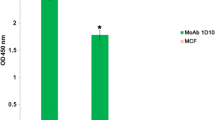Abstract
The antigens recognized by hyperimmune rabbit serum raised against tachyzoites of the NC-1 isolate ofNeospora caninum were characterized using chemiluminescent Western blotting, immunogold-silver staining and immunoelectron microscopy. Approximately 20 immunodominant antigens whose relative rates of migration were 16–80 kDa were recognized by the serum in Western blots using reduced or nonreduced parasite antigen preparations. The nonreduced parasite antigens were more strongly recognized by the serum than were the reduced antigen preparations. Immunoelectron microscopy revealed that the rabbit-serum-labeled antigens were localized to some organelles ofN. caninum tachyzoites and to the parasitophorous vacuole surrounding them. In particular, antigens found in the dense granules, in the micronemes, and in the posterior portion of the rhoptries were strongly labeled by an indirect immunogold-labeling technique
Similar content being viewed by others
References
Anderson ML, Blanchard PC, Barr BC, Dubey JP, Hoffman RL, Conrad PA (1991)Neopsora-like protozoan infection as a major cause of abortion in California dairy cattle. J Am Vet Med Assoc 198:241–244
Crewther PE, Culvenor JG, Silva A, Cooper JA, Anders RF (1990)Plasmodium falciparum: two antigens of similar size are located in different compartments of the rhoptry. Exp Parasitol 70:193–206
Dubey JP (1990)Neospora caninum: a look at a newToxoplasma-like parasite of dogs and other animals. Compend Continuing Ed Pract Vet 12:653–663
Dubey JP, Carpenter JL, Speer CA, Topper MJ, Uggla A (1988) Newly recognized fatal protozoan disease of dogs. J Am Vet Med Assoc 192:1269–1285
Dubremetz J-F, Dissous C (1980) Characteristic proteins of micronemes and dense granules fromSarcocystis tenella zoites (Protozoa, Coccidia). Mol Biochem Parasitol 1:279–289
Entzeroth R (1985) Invasion and early development ofSarcocystis muris (Apicomplexa, Sarcocystidae) in tissue culture. J Protozool 32:446–453
Kimata I, Tanabe K (1987) Secretion byToxoplasma gondii of an antigen that appears to become associated with the parasitophorous vacuole membrane upon invasion of the host cell. J Cell Sci 88:231–239
Leriche MA, Dubremetz JF (1990) Exocytosis ofToxoplasma gondii dense granules into the parasitophorous vacuole after host cell invasion. Parasitol Res 76:559–562
Linder E, Thors C, Edberg F, Haglund S, Bonsdorff C-H von (1992) Generation of antibodies againstToxoplasma gondii antigen associated with dense granules and the parasitophorous vacuole of the host cell. Parasitol Res 78:175–178
Lindsay DS, Dubey JP (1989a) Immunohistochemical diagnosis ofNeospora caninum in tissue sections. Am J Vet Res 50:1981–1983
Lindsay DS, Dubey JP (1989b) In vitro development ofNeospora caninum (Protozoa: Apicomplexa) from dogs. J Parasitol 75:163–165
Sam-Yellowe TY, Shio H, Perkins ME (1988) Secretion ofPlasmodium falciparum rhoptry protein into the plasma membrane of host erythrocytes. J Cell Biol 106:1507–1513
Schwartzman JD, Krug EC (1989)Toxoplasma gondii: characterization of monoclonal antibodies that recognize rhoptries. Exp Parasitol 68:74–82
Speer CA, Reduker DW, Burgess DE, Whitmire WM, Splitter GA (1985) Lymphokine-induced inhibition of growth ofEimeria bovis andEimeria papillata (Apicomplexa) in cultured bovine monocytes. Infect Immun 50:566–571
Torii M, Adams JH, Miller LH, Aikawa M (1989) Release of merozoite dense granules during erythrocyte invasion byPlasmodium knowlesi. Infect Immun 57:3230–3233
Willingham MC, Pastan I (1990) A reversible multi-well chamber for incubation of cultured cells with small volumes: application to screening of hybridoma fusions using immunofluorescence microscopy. Biotechniques 8:320–324
Author information
Authors and Affiliations
Rights and permissions
About this article
Cite this article
Barta, J.R., Dubey, J.P. Characterization of anti-Neospora caninum hyperimmune rabbit serum by Western blot analysis and immunoelectron microscopy. Parasitol Res 78, 689–694 (1992). https://doi.org/10.1007/BF00931522
Accepted:
Issue Date:
DOI: https://doi.org/10.1007/BF00931522



